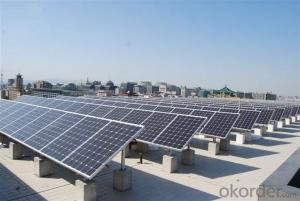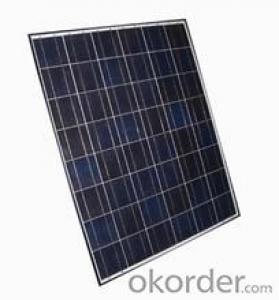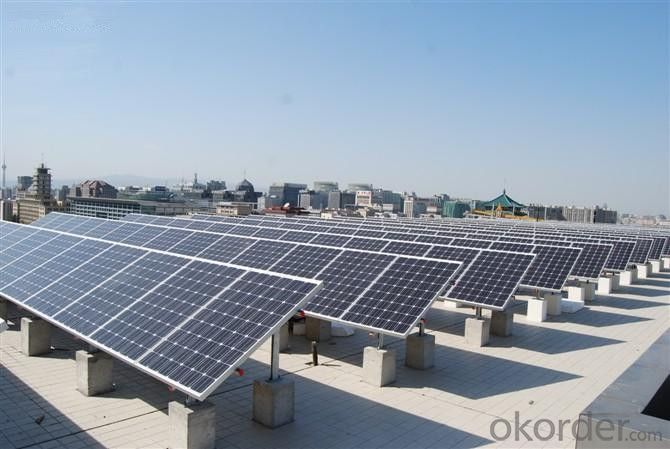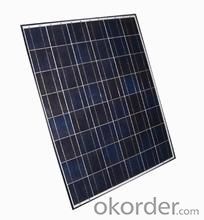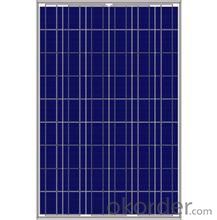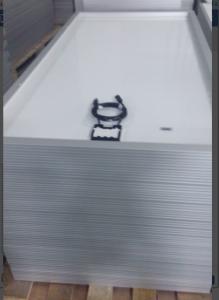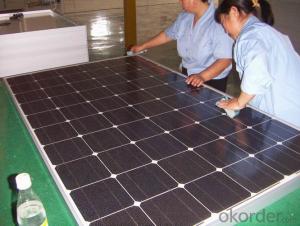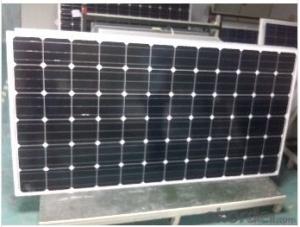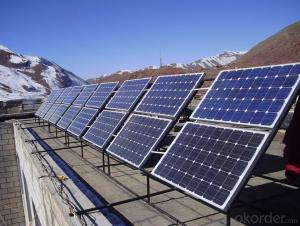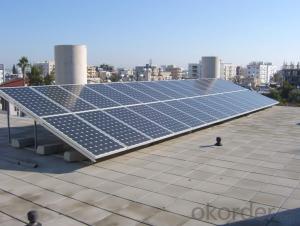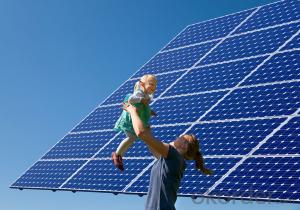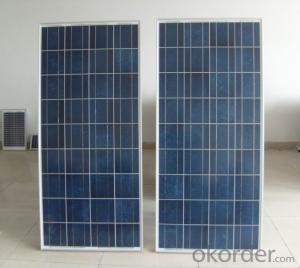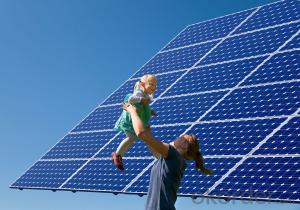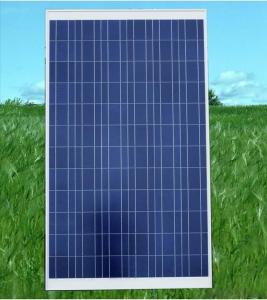Wholesale Solar Panels Kits - 255w Solar Panel Silicon Polycrystalline
- Loading Port:
- Nanjing
- Payment Terms:
- TT OR LC
- Min Order Qty:
- 200000 watt
- Supply Capability:
- 20000000 watt/month
OKorder Service Pledge
OKorder Financial Service
You Might Also Like
We are a high-tech group which specializes in solar products design,research, manufacture, sales,solar projects design and installation.
Our national sales service covers seven parts, including northeast, north, east, middle, south, northwest and southwest, international sales covers five continents and over forty countries, including Germany, Italy, Spain, France, America and Brazil etc.
1. GENERAL INFORMATION
(INCLUDING WARING AND SAFETY)
The installation of PV modules requires a great degree of skill and should only be performed by a qualified licensed professional, including licensed contractors and licensed electricians. Please be aware that there is a serious risk of various types of injury occurring during the installation including the risk of electric shock. All CUSTOMER modules are equipped with a permanently attached junction terminal box that will accept variety of wiring applications or with a special cable assembly for ease of installation, and they do not require assembly.
2. INTRODUCTION
This installation Manual contains essential information for the electrical and mechanical installation that your must know before installing CUSTOMER PV modules. This also contains safety information you need to be familiar with .All the information described in this manual are the intellectual property of CNBM and based on the technologies and experiences that have been acquired and accumulated in the long history of CUSTOMER. This document does not constitute a warranty, expressed or implied.
CUSTOMER does not assume responsibility and expressly disclaims liability for loss, damage, or expense arising out of in anyway connected with installation, operation, use or maintenance of the PV modules. No responsibility is assumed by CUSTOMER for any infringement of patents or other rights of third parties that may result from use of PV module.
CUSTOMER reserves the right to make changes to the product, specifications or installation manual without prior notice.
GENERAL WARNING
1. Before you attempt to install wire, operate and maintain the PV module, please make sure that you completely understand the information described in this installation manual.
2. Contact with electrically active parts of a PV module such as terminals can result in burns, sparks and lethal shock whether the PV modules is connected or not.
3. PV modules produce electricity when the sufficient sunlight or other sources illuminate the module surface. When the modules are connected in series, voltage id cumulative . When the modules are connected in parallel, current is cumulative. As a result, a large-scale PV system can produce high voltage and current which could present an increased hazard and may cause serious injury or death.
4. Do not connect the PV modules directly to the loads such as motor since the variation of the output power depending on the solar irradiation cause damage for the connected motor.
1:In the case of a blushless motor, the lock function becomes active and the hall IC is most likely to be damaged.
2:In the case of a brush type motor, the coil is most likely to be damaged.
WORK PRINCIPLE
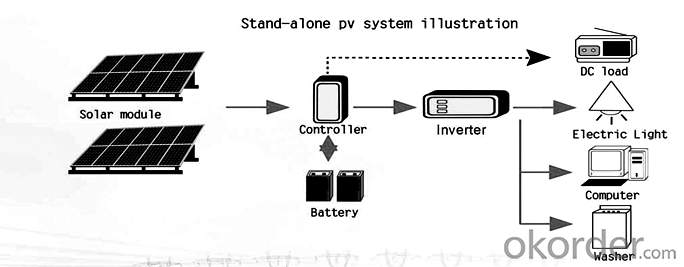
GENERAL SAFETY
1. Consult local codes and other applicable laws concerning required permits on regulations concerning installation and inspection requirements.
2. Before installation a PV module, contact appropriate authorities to determine permit, installation and inspection requirements that should be followed.
3. Install PV modules and ground frames in accordance with applicable rules and regulations
4. PV modules should be installed and maintained by qualified personnel. Only installer/service personnel should have access to the PV module installation site.
5. No matter where the PV modules are installed, either roof mounted construction or any other type of structures above the ground, appropriate safety practices should be followed and required safety equipment should be used in order to avoid possible safety hazards. Note that the installation of some PV modules on roofs may require the addition of fireproofing, depending on local building / fire codes.
6. Please use PV modules with same cell size within series.
7. Follow all safety precautions of other components used in the system.
8. In order to avoid a risk of injury or electrical shock, do not allow anyone to approach the PV module if the person has little knowledge on PV module or on the measures that should be taken when PV modules are damaged.
9. Do not clean the glass surface with chemicals. Do not let water stay on the glass surface of PV modules for a long time. This creates a risk of white efflorescence(glass disease) which may result in the deterioration of energy generation.
10. Do not clean the glass surface with chemicals. Do not let water stay on the glass surface of PV modules for a long time. This creates a risk of white efflorescence ( glass disease ) which may result in the deterioration of energy generation.
11. Do not install the PV module horizontally. It may cause dirt or white efflorescence (glass disease) due to water.
12. Do not cover the water drain holes of the frame. There is a risk of frost damage when the frame is filled with water copulation.
13. When sliding snow load has to be considered, an appropriate measure has to be taken so that PV module frames on lower edge of PV modules will not be damaged.
14. Do not expose PV module to sunlight concentrated with mirrors, lenses or similar means.
15. Turn off inverters and circuit breakers immediately, should a problem occur.
16. In case the glass surface of a PV module is broken, wear goggles and tape the glass to keep the broken pieces in place.
17. A defective PV module may generate power ever if it is removed from the system. It may be dangerous to handle the PV module while exposed to sunlight. Place a defective PV module in a carton so PV cells are completely shaded.
18. In case of series connection , the maximum open circuit voltage must not be greater than the specified maximum system voltage. The voltage is proportional to the number of series. In case of parallel connection, please be sure to take proper measure to block the reverse current flow. The current may easily flow in a reverse direction.
HANDLING SAFETY
1. Do not cause an excessive load on the surface of PV module or twist the frame. The glass surface can easily break.
2. Do not stand or step on the PV module. The surface glass of PV module is slippery.
3. Do not hit or put excessive load on the glass or brake film. The PV cell is very thin and can be easily broken.
4. Do not scratch or hit at the back film. The back film is vulnerable.
5. Do not hit the terminal box or do not pull the cables. The terminal box can crack and break.
6. Never touch terminal box or the end of output cables with bare hands when the PV module is irradiated. Cover the surface of PV module with cloth or other suitable sufficiently opaque material to isolate the PV module from incident light and handle the wires with rubber-gloved hands to avoid electric shock.
7. Do not scratch the output cable or bend it with force. The insulation of output cable can break and may result in electricity leakage or shock.
8. Do not pull the output cable excessively. The output cable may unplug and cause electricity leakage or shock.
9. Do not drill holes in the frame. It may compromise the frame strength and cause corrosion of the frame.
10. Do not scratch the insulation coating of the frame(except for grounding connection).It may cause corrosion of the frame or compromise the framework strength.
11. Do not loosen or remove the screws of the PV module. It may compromise the joint strength of PV module and cause corrosion.
12. Do not touch the PV module with bare hands. The frame of PV modules has sharp edges and may cause injury.
13. Do not drop PV module or allow objects to fall down on the PV module.
14. Do not try artificially to concentrate sunlight on the PV module.
INSTALLATION SAFETY
1. Always wear protective head gear, insulating gloves and safety shoes (with rubber soles).
2. Keep the PV module packed in the carton until installation.
3. Do not touch the PV module unnecessarily during installation. The glass surface and the frames get hot. There is a risk of burn, or you may collapse because of electric shock.
4. Do not work under rain, snow or windy conditions.
5. Use insulated tools
6. Do not use wet tools
7. Do not drop tools or hard objects on PV modules
8. When installing PV modules far above ground, do not drop any object(e.g. PV module or tools).
9. Make sure flammable gases are not generated near the installation site.
10. Completely cover the PV module surface with an opaque material during PV module installation and wiring.
11. Plug in the connector tight and ensure the wiring work.
12. Due to the risk of electrical shock, do not perform any work if the terminals of PV module are wet.
13. Do not touch the terminal box and the end of output cable ends ( connectors) with bare hands during installation or under sunlight, regardless of whether the PV module is connected to or disconnected from the system.
14. Do not unplug the connector if the system circuit is connected to a load.
15. Do not stamp on the glass at work. There is a risk of injury or electric shock if glass is broken.
16. Do not work alone (always work as a team of 2 or more people).
17. Wear a safety belt if working far above the ground.
18. Do not wear metallic jewelry which can cause electric shock during installation.
19. Do not damage the surrounding PV modules or mounting structure when replacing a PV module.
20. Bind cables by the insulation locks. Drooping down of cables from the terminal box could possibly cause various problems such as animal biting electricity leakage in puddle.
3.COMPONENTS
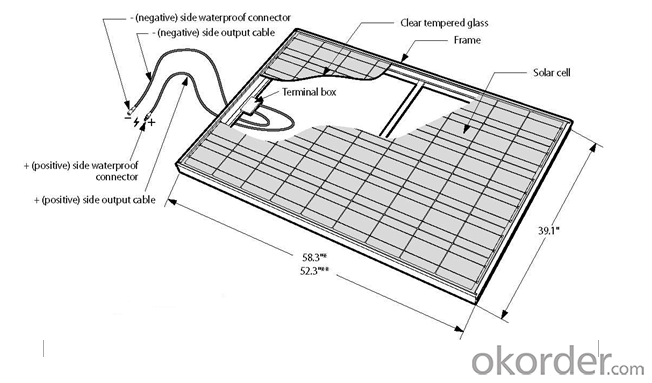
4. SITE SELECTION
In most applications, the PV modules should be installed in location where there is no shading throughout the year. In the Northern Hemisphere, The PV modules should typically face south, and in the Southern Hemisphere, the PV modules should typically face north. Please make sure that there are no obstruction in the surroundings of the site of installation. Take proper steps in order to maintain reliability and safety, in case the PV modules are used in areas such as: Heavy snow areas/Extremely code areas/ Strong wind areas/Installation over, or near, water/ Areas where installations are prone to salt water damage (*)/Small islands or desert areas.(*)
If you are planning to use the PV modules where the salt water damage may be possible consult with CNBM local agent first to determine an appropriate installation method, or to determine whether the installation is possible?
5. TILT ANGLE
The title angle of the PV module is the measured between the PV module and a horizontal ground surface. The PV module generates the maximum output power when it faces the sun directly.
For the standalone systems with a battery where the PV modules are attached to a permanent structure , the tile angle of the PV modules should be determined to optimize the performance when the sunlight is the scarcest. In general, if the electric power generation is adequate when the sunlight is the scarcest, then the angle chosen should be adequate during the rest of the year. For grid-connected installations where the PV modules are attached to a permanent structure, it is recommended to tilt the PV module at the angle equal to the latitude of the installation site so that the power generation from the PV module will be optimum throughout the year.
6. WIRING
To ensure proper system operation to maintain your warranty, observe the correct cable connection polarity(Figures 1&2) when connecting the modules to a battery or to other modules. If not connected correctly, the bypass diode could be destroyed.
PV modules can be wired in series to increase voltage. Connect wires from the positive terminal of one module to the negative of the next module. Figure shows modules connected in series .
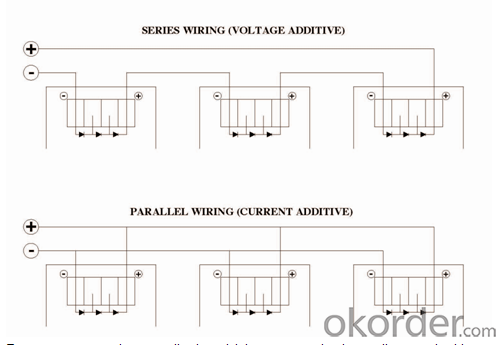
7. INSTALLATION
Refer to installation manual of individual models of PV module.
8.ELECTRICAL RATINGS
Refer to installation manual of individual models of PV module.
9. GROUDING
All PV models must be grounded by electrical connection of the module frames to ground. Please be careful in arranging the system ground so that the removal of one module from the circuit will not interrupt the grounding of any other modules.
The modules should be grounded to the same electrical point as described below.
Each PV module has a hole on the side frame of either a bolt, nut and washer grounding the module to the frame, a ground lug fastened by bolt or screw, or appropriate screw(hardware not provided).An example of acceptable ground connection using a bolt, nut and washer retaining a ground lug is shown in figure 3,in a connection of this type, the hardware(such as a toothed locked washer/star washer) must score the frame surface to make positive electrical contact with the frame. The ground wire must be considered within the requirement of local and regulation at the site of installation.
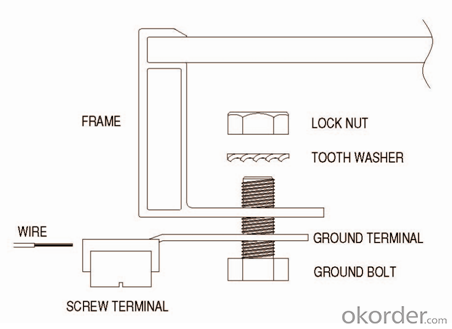
10.MOUNTING
Please make sure that all the information described in the installation manual is still valid and proper for your installation. The mounting method has been verified by CNBM and NOT CERTIFIED by a third party organization.
The approved way to mount CNBM PV modules to a support structure is using the bolt holes provided as described in the Specifications. Although CNBM does not specify or warrant frame clips or clamps, using frame clips (not provided ) or clamps module (not provided ) is also possible when they are designed for PV modules and with minimum dimensions on the sides of the module in accordance with the instructions and drawings provided. If using frame clips or clamps, the modules should be fixed rigidly and there shall be no damage to the modules by deforming mounting structure against design load. CNBM does not specify or warrant frame clips. The CNBM module warranty may be void if customer-selected trame clips which are improper or inadequate with respect to the module properties(including strength or material)or installation. Note that if metal clips are used, there must be a path to ground from the clips.(for instance, using star washers in the clip hardware set). Please review the descriptions and drawings carefully; not mounting the modules according to one of these methods may void your warranty. These mounting methods are designed to allow module loading of 2400pa.
11.MAINTENANCE
The modules are designed for long life require very little maintenance. If the angle of the PV module is 5degrees or more, normal rainfall is sufficient to keep the module glass surface clean under most weather conditions. If dirt build-up become excessive, clean the glass surface only with a soft cloth using water. If cleaning the back of the module is required, take utmost care not to damage the back side materials. In order to ensure the operation of the system, please check the connection of wiring and the state of the jacket of wires every now and then.

- Q: Can solar panels be used in combination with wind turbines?
- Yes, solar panels can be used in combination with wind turbines. This combination of renewable energy sources allows for a more reliable and consistent power generation, as wind and sunlight are complementary in nature. By integrating solar panels and wind turbines, the system can generate electricity during both day and night, as well as in varying weather conditions, maximizing energy output and increasing overall efficiency.
- Q: We are considering getting solar panels for our home just south of Birmingham, AL. We know a little and are trying to educate ourselves the best we can. But we are having a hard time finding anyone around this area. We have done the yellow page thing, and some quot;green places around town. But to no luck.....
- Any electrical contractor could likely install them, and there are several Internet businesses that sell solar panels. You likely have no place there to get the kind of large panels you need for a house. Look at your local regulations. Your utility may not allow grid-tie, so you may have to set up an off-grid system with batteries and use separate wiring or a transfer switch. One thing a lot of people neglect is hail protection. In Birmingham, you're likely to have large hail (larger than golf ball size) every couple of years in the spring. You need to work out a way of covering them in advance of severe weather. Most panels will take up to golf-ball size hail with no problem. DK PS, I've done this myself, and have considerably more information. Email if you're interested.
- Q: Can solar panels be used for air conditioning?
- Yes, solar panels can be used to power air conditioning systems. Solar panels generate electricity from sunlight, which can be used to operate air conditioning units. This allows for cooling without relying on traditional electricity sources, reducing energy costs and environmental impact.
- Q: Hi, I am starting to get curious about the pros/cons of installing solar panels - has anyone done it and is it worth it?
- If okorder and I mention them only because they did a retro fit on my Uncle's house in the Florida Keys and a smaller scale system for my in laws outside of Chicago. Both my Uncle and In Laws really are enjoying the cost savings that they are getting each month from their respective systems, and both said that Sun's initial costs were QUITE low. Be sure to have the blessing of your local building zoning departments before installing the panels as some municipalities take issue with solar panels. Also make sure that your roof is strong enough to withstand the weight of not only the panels, but the bracing. Good Luck.
- Q: how fast does a 25watt solar panel generate power to a battery? trying to figure out a conversion factor here to get a rough estimate of how many i would need to power my house, please help?
- Small house needs at least 0000 watts at peak power. Therefore your need 80 pieces of 25 watts solar panels.
- Q: I need to reduce the average monthly home electricity bill by powering some of the household appliances using solar panels. Can I use a 250 watt solar panel to power a medium sized upright fridge?
- How many watts does your fridge consume? Do you want it to work at night when the solar panels aren't doing anything? Probably not.
- Q: Can it be used on a cellphone so u never have to worry about low battery?
- they are a long way from producing enough electricity to keep a cell phone charged. but maybe some day in the future. but as our culture is recognizing the importance of solar electricity they are starting to mass produce solar panels and creating major problems of wast when they get old and stop producing electricity. they are super toxic and shouldnt be thrown away. they will prob have special places set of for those in the future.
- Q: I have purchased a 2 volt LED lantern from argos, it comes with a built in 6 volt 4ah sealed acid battery. What I wanted to know is would I be able to charge it using my 6 volt solar panel?
- If it has a 6 volt battery- is it marked 2 volts on an external plug? If so, there is a resistor inside to drop the potential the battery sees. The battery itself could be slipped out and recharged easily from your 6 volt panel. Just determine how much current (in Amps or Milliamps) the panel produces nominally and divide that into 4 and add one fourth of that length of time to make up for system losses. This will tell you how many hours it should charge assuming your starting voltage of the battery is above .5 volts. and the panel is at 3 volts potential or higher. So if your panel puts out amp at 0AM, you would charge for 5 hours. 4 divided by is 4 and one fourth of that is so 4 plus is 5. It is a little more involved than that, but as a rule of thumb. Also do not discharge tha lantern to the point of no light output. LEDs are efficient, but their current will add up. If it is suggest to be able to use the lantern for up to 8 hours on a charge, stick to that value. Lead acid batteries have best longevity when discharged only to 80 percent capacity. Once battery is charged- disconnect from charging source.
- Q: What is the average size of a solar panel?
- The average size of a solar panel is typically around 65 inches by 39 inches, or about 5.4 feet by 3.25 feet. However, the size can vary depending on the manufacturer and the specific model of the solar panel.
- Q: Can solar panels be installed on schools or educational institutions?
- Yes, solar panels can be installed on schools or educational institutions. In fact, many schools and educational institutions have already embraced solar energy as a sustainable and cost-effective solution. Installing solar panels not only helps reduce carbon emissions but also provides educational opportunities for students to learn about renewable energy and sustainability. Additionally, schools can benefit from reduced energy costs and potentially generate revenue by selling excess energy back to the grid.
Send your message to us
Wholesale Solar Panels Kits - 255w Solar Panel Silicon Polycrystalline
- Loading Port:
- Nanjing
- Payment Terms:
- TT OR LC
- Min Order Qty:
- 200000 watt
- Supply Capability:
- 20000000 watt/month
OKorder Service Pledge
OKorder Financial Service
Similar products
Hot products
Hot Searches
